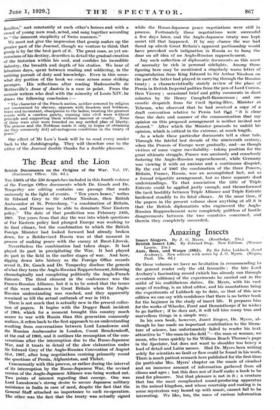Amazing Insects
Insect Singers. By J. G. Myers. (Routledge. 210.)
Ants, Bees, and Wasps (1882). By Sir John Lubbock (Lord Avebury). New edition with notes by J. G. Myers. (Kegan, Paul. 10s. 6d.)
OF these volumes we have no hesitation in recommending to the general reader only the old favourite : the late Lord Avebury's fascinating record (which has already run through seventeen editions) of the experiments he carried out in the midst of his multifarious duties. Dr. Myers, with his vast range of reading, is an ideal editor, and his annotations bring the experiments of Lubbock up to date, so that of this new edition we can say with confidence that there is no better book for the beginner in the study of insect life. It prepares him for the works of Wheeler, Forel and Donnisthorpe if he wishes to go further ; if he does not, it will tell him many true and
marvellous things in a simple way.
In his own book, however, Insect Singers, Dr. Myers, al- though he has made an important contribution to the litera- ture of science, has unfortunately failed to render his text attractive to "the-man-in-the-field "—the man or woman, we mean, who turns quickly to Sir William Beach Thomas's page in the Spectator, but does not want to shoulder too heavy a load of detail and Latin names. Had Dr. Myers been writing solely for scientists no fault or flaw could be found in his work. There is much patient research here published for the first time (in particular Mrs. Myers' chapter on the music of cicadas) and an immense amount of information gathered from all climes and ages ; but this does not of itself make a book to be read for pleasure. Not that pleasure is not in it ; a creature that has the most complicated sound-producing apparatus in the animal kingdom, and whose courtship and mating is in some mysterious way bound up with music, cannot fail to be interesting. We like, too, the mass of curious information
that has been unearthed----Items such as that the ancients considered cicadas a specific for gall stones when powdered and mixed with hypoeras and the blood of a he-goat. But the " Fabre touch" is lacking ; the book is a valuable collec- tion of scientific and literary notes, neither less nor more.
• British Insect Life, now republished after eight years, with some good illustrations by Mr. Alfred Priest, is designed entirely as a popular work. It contains matter of delight to the amateur nature-lover, who has probably forgotten, for instance, that in a restricted area of the Hampshire coast a British earwig is to be found which is three times as long and twice as broad as the average specimen ; and that the common cockroach is an unpleasant alien from Central .Europe; and that the tiny red ant, monontorium pharaonis, which eats the housewife's sugar, is also a foreigner ; and that the caterpillar of the Adonis Blue butterfly. is milked by our British ants and kept as a cow. The majority of .insects likely to be seen on a country walk will be foimd described here, and the work is useful as a -conspectus. Bat the wonder and glory of Nature as Hudson, Lubbock,.Fabre, or Miss Frances Pitt communicate it to us is not to be discovered in Mr. Step's matter-of-fact pages.
We return to the financier, politician and scientist who gave us bank holidays and the first popular 'books on insects. (Fabre was writing, but unknown and neglected.) Lord Avebury looked on ants as friends; and although he did not cross the " t's " and dot the " i 's" of the lessons they have
• for us, a passage such as this (the reader must remember -it was written nearly half a century ago) will show the range . of his mind. (We have abridged the extract slightly.) "We find in the different species of 'ants different conditions of , life cur ously answering to the, different stages of human progress. For instance, some species live principally on the produce of the chase. They resemble the lower races of men, who subsist mainly bY hunting. Such species as the " LaSius flEivus " represent a dis- tinctly higher type of social life ; they show more skill in archi- • tecture, may be literally said to have domesticated certain species of aphides and may be compared to the pastoral stage of human pro- gress—to the races which live on the produce of their flocks and herds. I am disposed to hazard the conjecture that they will gradually exterminate the mere hunting species, just as savages .disappear before the more advanced races. Lastly, the agricultural nations may be compared to the harvesting ants.'
The new notes by Dr. Myers, as we have already said, add greatly to the value of the book. We shall only mention one of them, prepared from a paper appearing last year entitled "A remarkable bug that lures ants to 'heir destruction." This Javanese siren is _probably the most curious creature in all the fantastic world of insect biology. She possesses and yields. on occasion a juice of intoxicating and deadly delight to the ant. When she sees a victim, she raises her body into an inviting position ; the ant rushes in and begins to lick the paradisiacal milk of the murderess ; in a Minute or two stupefaction sets in, and the ant, still licking feebly, sways and staggers at its drinking. Then the seductress (ptilocerns ochraceus is her name) seizes her fainting guest with her front legs, and pierces it and sucks it dry.











































 Previous page
Previous page